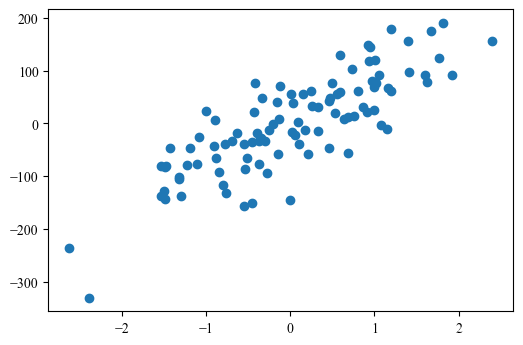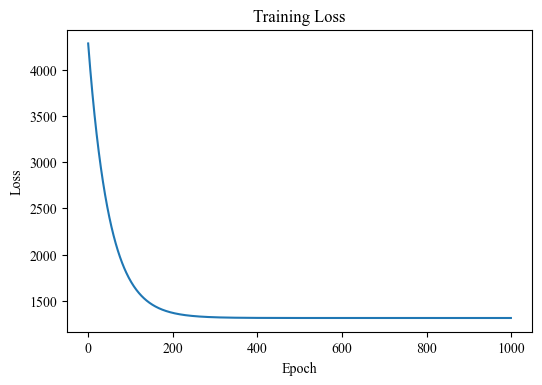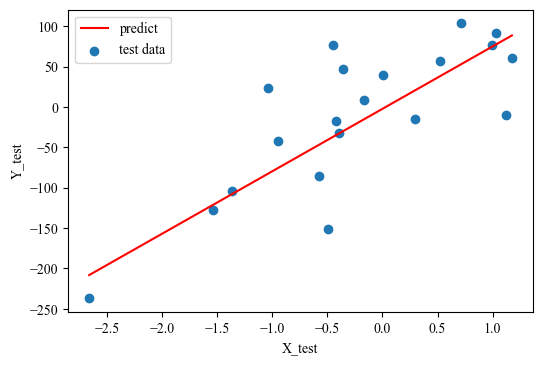目录
一、理论知识
1、一元线性回归模型(映射函数)
其中,表示输入,
表示输出,
和
表示可学习的权重参数。
2、损失函数(代价函数)
其中,是标签,
是预测值。
3、梯度计算
注:梯度计算遵循的是矩阵求导法则和链式求导法则。
4、梯度下降
其中,A是梯度下降步长,又称学习率。多次迭代执行前向传播(计算映射函数)和反向传播(梯度计算+梯度下降),损失函数最终收敛至局部最优解。
二、代码实现
1、导入Python包
import numpy as np
import matplotlib.pyplot as plt
from sklearn.model_selection import train_test_split
from sklearn.metrics import mean_squared_error
from sklearn.datasets import make_regression
plt.rcParams['font.sans-serif'] = ['Times New Roman']2、利用sklearn构造线性回归数据集
X, Y = make_regression(n_samples=100, n_features=1, noise=50, random_state=2024)
plt.figure(dpi=100)
plt.scatter(X, Y)3、定义并初始化权重参数 W 和 b
weights = np.zeros((1, 1))
bias = 04、前向传播函数:计算映射函数
def forward(X, weights, bias):
Y_hat = np.dot(X, weights) + bias
return Y_hat5、损失计算函数
def Loss_fuction(Y, Y_hat):
N = Y.shape[0]
cost = 1 / (2 * N) * np.sum((Y_hat - Y) ** 2)
return cost6、反向传播函数:梯度下降
def backward(X, Y, Y_hat, weights, bias, lr):
# 梯度计算
N = Y.shape[0]
dw = 1 / N * np.dot(X.T, (Y_hat - Y))
db = 1 / N * np.sum(Y_hat - Y)
# 权重更新
weights -= lr * dw
bias -= lr * db
return weights, bias7、数据预处理:特征归一化 + 调整维度
X = (X - np.mean(X, axis=0, keepdims=True)) / (np.std(X, axis=0, keepdims=True) + 1e-8)
Y = Y[:, None]8、划分训练集和测试集
X_train, X_test, Y_train, Y_test = train_test_split(X, Y, test_size=0.2, random_state=2024)
print(X_train.shape, X_test.shape, Y_train.shape, Y_test.shape)(80, 1) (20, 1) (80, 1) (20, 1)
9、模型训练
lr = 0.01 # 学习率
epochs = 1000 # 迭代次数
train_loss = []
for _ in range(epochs):
# 前向传播
Y_hat = forward(X_train, weights, bias)
# 损失计算
loss = Loss_fuction(Y_train, Y_hat)
train_loss.append(loss)
# 反向传播
weights, bias = backward(X_train, Y_train, Y_hat, weights, bias, lr)
plt.figure(dpi=100)
plt.plot(train_loss)
plt.xlabel("Epoch")
plt.ylabel("Loss")
plt.title("Training Loss")
plt.show()10、模型测试
plt.figure(dpi=100)
plt.scatter(X_test[:,0], Y_test[:,0], label='test data')
lin_x = np.linspace(np.min(X_test[:,0]), np.max(X_test[:,0]), 100)
lin_y = forward(lin_x[:,None], weights, bias)[:,0]
plt.plot(lin_x, lin_y, 'r', label='predict')
plt.legend()
plt.xlabel('X_test')
plt.ylabel('Y_test')
plt.show()
y_predict = forward(X_test, weights, bias)
print(f"Test MSE: {mean_squared_error(y_predict, Y_test)}")
Test MSE: 3130.9712952593727
























 2416
2416

 被折叠的 条评论
为什么被折叠?
被折叠的 条评论
为什么被折叠?








